Employment Law
Added on 2023-01-11
29 Pages9355 Words54 Views
Employment Law
Employment Law
[Author Name(s), First M. Last, Omit Titles and Degrees]
[Institutional Affiliation(s)]
Author Note
Employment Law
[Author Name(s), First M. Last, Omit Titles and Degrees]
[Institutional Affiliation(s)]
Author Note
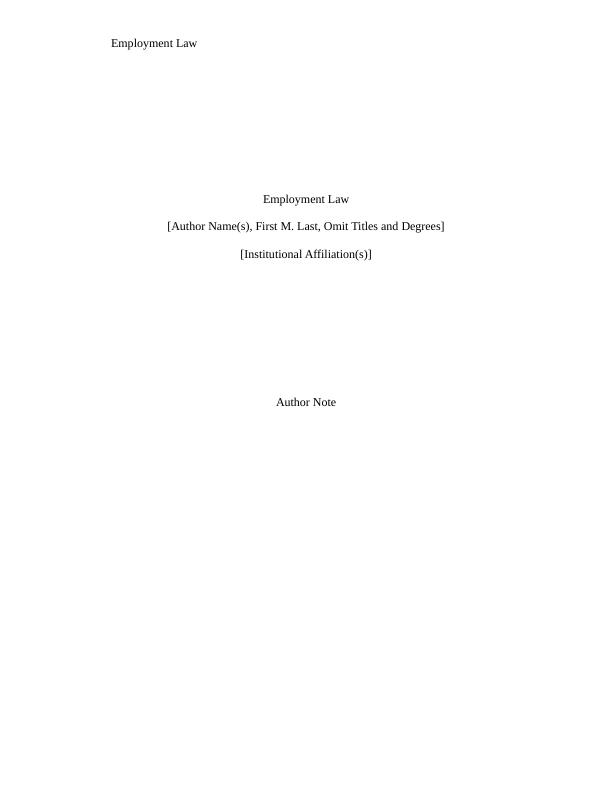
Employment Law 1
Contents
Introduction..........................................................................................................................1
PART I.................................................................................................................................1
The Concept of flexicurity...............................................................................................1
Flexicurity in Denmark................................................................................................3
Denmark Measures......................................................................................................5
PART II................................................................................................................................7
Changes in the Employer's Responsibility on Health and Safety of Employees.............7
Stress, Depressive Disorders and Harassment in Labour Protection...............................9
PART III.............................................................................................................................12
Employers’ Solution to Employees’ industrial action and strike...................................12
Legal implications: Trade Union and Labor Relations (Consolidation) Act 1992
(TULRCA).................................................................................................................................14
Different Types of Dispute.............................................................................................15
The Use of Injunctions...................................................................................................15
Dismissal and Re-engagement.......................................................................................16
PART IV.............................................................................................................................16
International Transport Workers' Federation (ITWF) v Viking Line ABP (C-438/05)......16
Conflicts Resolution: Economic fundamental freedoms and trade unions' rights in
collective bargaining......................................................................................................................18
Contents
Introduction..........................................................................................................................1
PART I.................................................................................................................................1
The Concept of flexicurity...............................................................................................1
Flexicurity in Denmark................................................................................................3
Denmark Measures......................................................................................................5
PART II................................................................................................................................7
Changes in the Employer's Responsibility on Health and Safety of Employees.............7
Stress, Depressive Disorders and Harassment in Labour Protection...............................9
PART III.............................................................................................................................12
Employers’ Solution to Employees’ industrial action and strike...................................12
Legal implications: Trade Union and Labor Relations (Consolidation) Act 1992
(TULRCA).................................................................................................................................14
Different Types of Dispute.............................................................................................15
The Use of Injunctions...................................................................................................15
Dismissal and Re-engagement.......................................................................................16
PART IV.............................................................................................................................16
International Transport Workers' Federation (ITWF) v Viking Line ABP (C-438/05)......16
Conflicts Resolution: Economic fundamental freedoms and trade unions' rights in
collective bargaining......................................................................................................................18
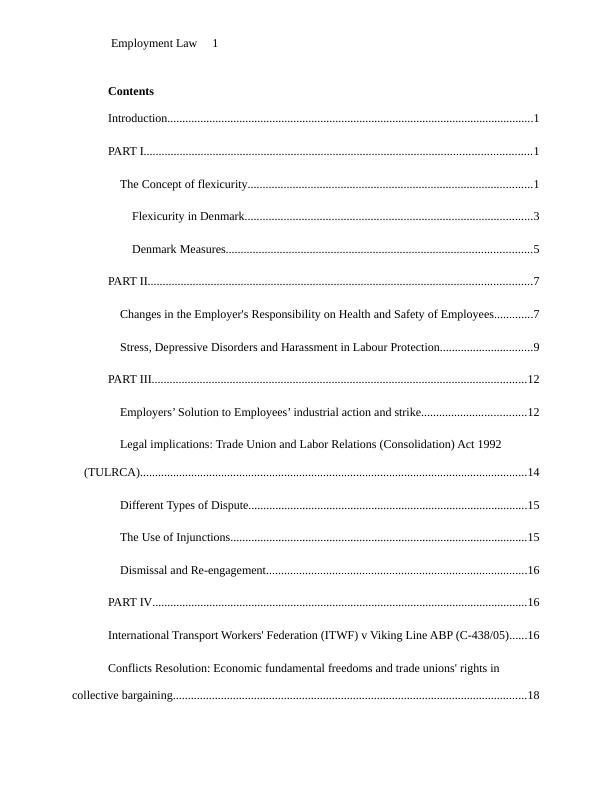
Employment Law 2
PART VI.............................................................................................................................20
Conclusion.........................................................................................................................23
Bibliography......................................................................................................................25
PART VI.............................................................................................................................20
Conclusion.........................................................................................................................23
Bibliography......................................................................................................................25
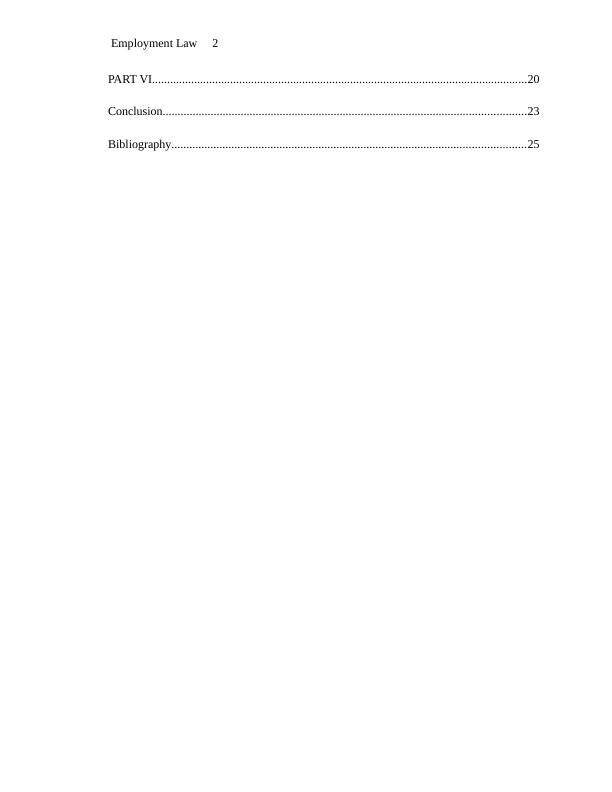
Employment Law 3
Introduction
The increasing globalization occupied with demands for sustainable management,
political accountability, and institutional governance has led to a need for adjustment of
regulatory frameworks for employment and labor. Against this contextual, governments have
come up with regulations and terms all with the intention of shaping the employment
relationships. An important aspect is the enactment of international principles that that now
govern employment relations both for people working within a country and the workers posted to
a foreign country. The article intends to discuss important features related to the concept of
flexicurity, work safety and health, industrial actions and trade unions, and the concept of
positive duties in promoting equality.
PART I
The Concept of flexicurity
The idea of flexicurity came as an approach of European Employment Strategy (EES).
The model later received its highest recognition when the European Commission (EC) and other
member states turned to it as an amalgamation between political support for the regulations of
socio-economic and those arguing for sustain.1 The EC defined flexicurity as an integrated
approach for enhancing flexibility in the labor market while at the same time maintaining job
security.2 Flexicurity came as the approach for tackling the structural changes brought by new
technologies and the slow economic growth. These were critical issues during the time for the
financial crisis which destabilized jobs causing industries to rush for flexibility as an attempt to
1 Mikkel Mailand, ‘The Common European Flexicurity Principles: How a Fragile Consensus Was
Reached’ (2010) 16 European Journal of Industrial Relations 241.
2 Commission of the European Communities (EC), ‘Communication from The Commission to The
European Parliament, The Council, The European Economic and Social Committee and The
Committee of The Regions’ (2007) <https://eur-lex.europa.eu/legal-content/EN/ALL/?
uri=CELEX:52007DC0359>.
Introduction
The increasing globalization occupied with demands for sustainable management,
political accountability, and institutional governance has led to a need for adjustment of
regulatory frameworks for employment and labor. Against this contextual, governments have
come up with regulations and terms all with the intention of shaping the employment
relationships. An important aspect is the enactment of international principles that that now
govern employment relations both for people working within a country and the workers posted to
a foreign country. The article intends to discuss important features related to the concept of
flexicurity, work safety and health, industrial actions and trade unions, and the concept of
positive duties in promoting equality.
PART I
The Concept of flexicurity
The idea of flexicurity came as an approach of European Employment Strategy (EES).
The model later received its highest recognition when the European Commission (EC) and other
member states turned to it as an amalgamation between political support for the regulations of
socio-economic and those arguing for sustain.1 The EC defined flexicurity as an integrated
approach for enhancing flexibility in the labor market while at the same time maintaining job
security.2 Flexicurity came as the approach for tackling the structural changes brought by new
technologies and the slow economic growth. These were critical issues during the time for the
financial crisis which destabilized jobs causing industries to rush for flexibility as an attempt to
1 Mikkel Mailand, ‘The Common European Flexicurity Principles: How a Fragile Consensus Was
Reached’ (2010) 16 European Journal of Industrial Relations 241.
2 Commission of the European Communities (EC), ‘Communication from The Commission to The
European Parliament, The Council, The European Economic and Social Committee and The
Committee of The Regions’ (2007) <https://eur-lex.europa.eu/legal-content/EN/ALL/?
uri=CELEX:52007DC0359>.
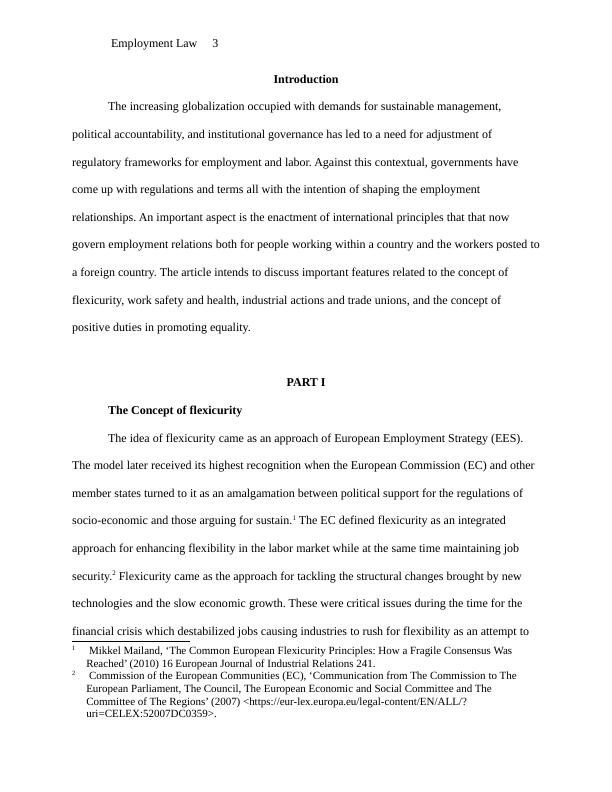
Employment Law 4
reduce costs of labor. On the other hand, flexicurity was more of a transition of the employee’s
course of life starting from school to employment, from one job to another, during
unemployment, and from during employment to the retirement.
Flexicurity is about employees’ progress into better jobs, and chances for developing their
talents. Flexibility as one element of flexicurity looks at the ability of the organization to quickly
identify their product requirements and skills, and facilitation of the employees’ combination of
both private life and work responsibilities. Security as the second element looks not only at the
ability of the employees to maintain a job, but also their growth which requires equipping them
with skills that enhance their progress through the career life, and their ability to secure future
employment. In 2006, the Commission explained that flexicurity comprised four “components.”
These components were flexibility and reliability in contractual arrangements, the efficacy, and
enforcement of policies for labor markets, all-inclusive lifelong learning plans, and modernized
systems for social security.
Flexicurity in Denmark
The Danish model has been regarded as the most successful and well-established in the
management of flexicurity agreements within the Danish labor markets.3 The Danish
understanding of flexicurity composes of three elements. These elements are; (i) protection of
low employment through legislation; (ii) generosity in offering unemployment benefits; (iii)
active policies for the labor market.4 The unique combination of these elements is the one called
the “golden triangle’’.5
3 Konstantinos Kougias, ‘‘Real’Flexicurity Worlds in Action: Evidence from Denmark and Greece’ <
http://eprints.lse.ac.uk/69576/> accessed 18 April 2019.
4 Sonja Bekker and Mikkel Mailand, ‘The European Flexicurity Concept and the Dutch and Danish
Flexicurity Models: How Have They Managed the Great Recession?’ (2019) 53 Social Policy &
Administration 142.
5 ibid.
reduce costs of labor. On the other hand, flexicurity was more of a transition of the employee’s
course of life starting from school to employment, from one job to another, during
unemployment, and from during employment to the retirement.
Flexicurity is about employees’ progress into better jobs, and chances for developing their
talents. Flexibility as one element of flexicurity looks at the ability of the organization to quickly
identify their product requirements and skills, and facilitation of the employees’ combination of
both private life and work responsibilities. Security as the second element looks not only at the
ability of the employees to maintain a job, but also their growth which requires equipping them
with skills that enhance their progress through the career life, and their ability to secure future
employment. In 2006, the Commission explained that flexicurity comprised four “components.”
These components were flexibility and reliability in contractual arrangements, the efficacy, and
enforcement of policies for labor markets, all-inclusive lifelong learning plans, and modernized
systems for social security.
Flexicurity in Denmark
The Danish model has been regarded as the most successful and well-established in the
management of flexicurity agreements within the Danish labor markets.3 The Danish
understanding of flexicurity composes of three elements. These elements are; (i) protection of
low employment through legislation; (ii) generosity in offering unemployment benefits; (iii)
active policies for the labor market.4 The unique combination of these elements is the one called
the “golden triangle’’.5
3 Konstantinos Kougias, ‘‘Real’Flexicurity Worlds in Action: Evidence from Denmark and Greece’ <
http://eprints.lse.ac.uk/69576/> accessed 18 April 2019.
4 Sonja Bekker and Mikkel Mailand, ‘The European Flexicurity Concept and the Dutch and Danish
Flexicurity Models: How Have They Managed the Great Recession?’ (2019) 53 Social Policy &
Administration 142.
5 ibid.
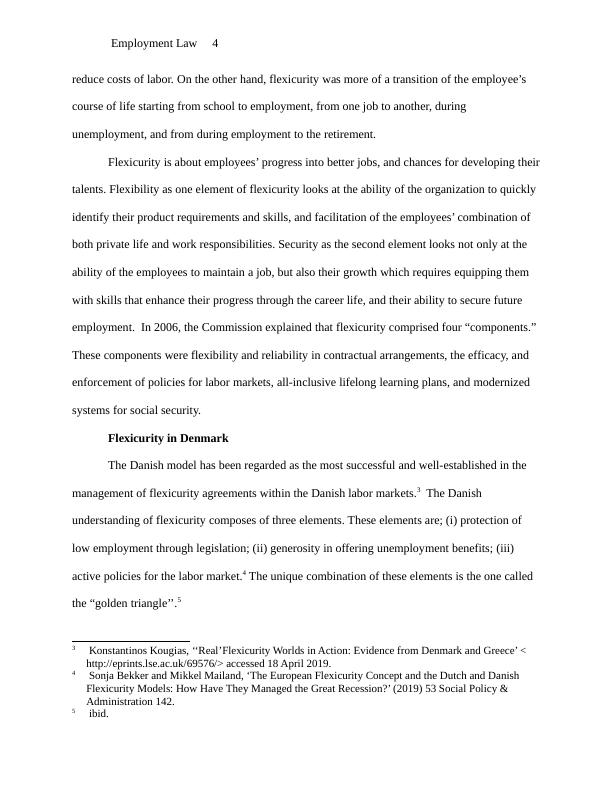
Employment Law 5
Under the first principle of protection of low employment through legislation, work
dismissals are subject to regulation which are a combination of principles from different
legislation and collective agreements.6 Altogether, these regulations bring certainty among
employees, employers, insurance funds, trade unions, and Jobcentres.7 While Danish employers
face strict rules against workers dismissal when compared to other countries, they also enjoy the
benefit of paying less since the statutory compensation payments are lower in Danish than other
countries.8
The second flexicurity principle allows Denmark to support the unemployed. The Danish
flexicurity model has a system that groups unemployed persons into insured and non-insured.
The insured receive unemployment benefits from insurance packages. However, this is subject to
their compliance with the rules. On the other hand, the non-insured persons are granted access to
social assistance. But like the insured, the must rule such as the testing conditions. In addition,
non-negligible unemployed are allowed to receive disability benefits.9 The elderly also receive
early retirement benefits.10The third Denmark model is the strong activation approach which
consists of rights and obligations for the people without jobs. The strategy requires the
unemployed to actively seek work, and the rules require them to participate in the compulsory
full-time activation programs. The data on the 2011 survey showed that Denmark spent 3.7% of
6 Ralf Rogowski and Thomas Kruppe, Labour Market Efficiency in the European Union Employment
Protection and Fixed-Term Contracts (Routledge 2013) <https://ezproxy.aub.edu.lb/login?
url=https://www.taylorfrancis.com/books/9781134728466> accessed 18 April 2019.
7 ibid.
8 Torben M Andersen, ‘The Danish Labor Market, 2000–2016: Despite Recession-Induced Job Losses,
High Turnover Prevented a Steep Increase in Long-Term and Youth Unemployment’ [2017] IZA
World of Labor < https://wol.iza.org/articles/the-danish-labor-market/long>.
9 OECD, Mental Health and Work: Denmark (OECD 2013) <
http://www.oecd.org/employment/mental-health-and-work-denmark-9789264188631-en.htm>
accessed 15 April 2019.
10 Organisation for Economic Co-operation and Development (ed), Ageing and Employment Policies:
Denmark 2015: Working Better with Age (OECD Publishing 2015).
Under the first principle of protection of low employment through legislation, work
dismissals are subject to regulation which are a combination of principles from different
legislation and collective agreements.6 Altogether, these regulations bring certainty among
employees, employers, insurance funds, trade unions, and Jobcentres.7 While Danish employers
face strict rules against workers dismissal when compared to other countries, they also enjoy the
benefit of paying less since the statutory compensation payments are lower in Danish than other
countries.8
The second flexicurity principle allows Denmark to support the unemployed. The Danish
flexicurity model has a system that groups unemployed persons into insured and non-insured.
The insured receive unemployment benefits from insurance packages. However, this is subject to
their compliance with the rules. On the other hand, the non-insured persons are granted access to
social assistance. But like the insured, the must rule such as the testing conditions. In addition,
non-negligible unemployed are allowed to receive disability benefits.9 The elderly also receive
early retirement benefits.10The third Denmark model is the strong activation approach which
consists of rights and obligations for the people without jobs. The strategy requires the
unemployed to actively seek work, and the rules require them to participate in the compulsory
full-time activation programs. The data on the 2011 survey showed that Denmark spent 3.7% of
6 Ralf Rogowski and Thomas Kruppe, Labour Market Efficiency in the European Union Employment
Protection and Fixed-Term Contracts (Routledge 2013) <https://ezproxy.aub.edu.lb/login?
url=https://www.taylorfrancis.com/books/9781134728466> accessed 18 April 2019.
7 ibid.
8 Torben M Andersen, ‘The Danish Labor Market, 2000–2016: Despite Recession-Induced Job Losses,
High Turnover Prevented a Steep Increase in Long-Term and Youth Unemployment’ [2017] IZA
World of Labor < https://wol.iza.org/articles/the-danish-labor-market/long>.
9 OECD, Mental Health and Work: Denmark (OECD 2013) <
http://www.oecd.org/employment/mental-health-and-work-denmark-9789264188631-en.htm>
accessed 15 April 2019.
10 Organisation for Economic Co-operation and Development (ed), Ageing and Employment Policies:
Denmark 2015: Working Better with Age (OECD Publishing 2015).
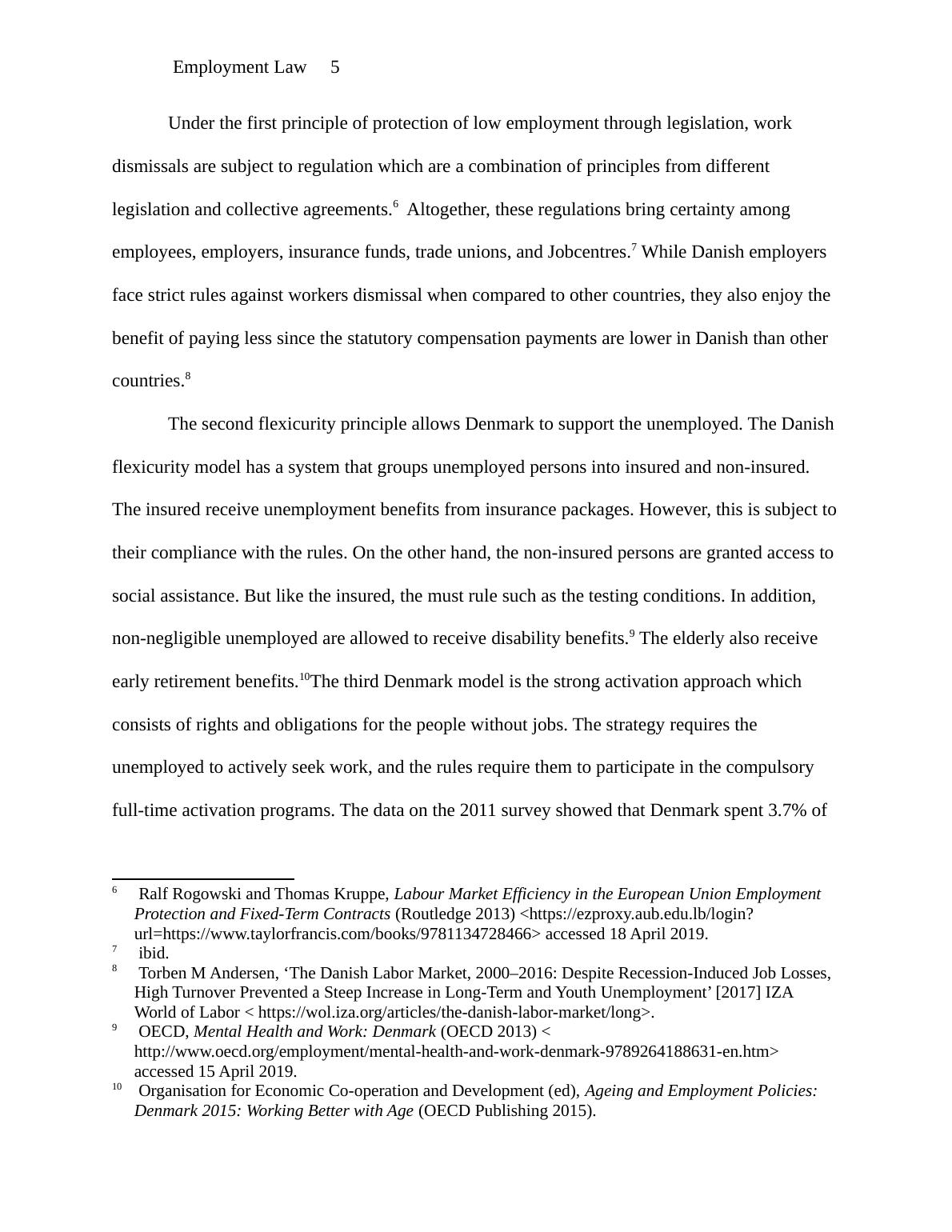
End of preview
Want to access all the pages? Upload your documents or become a member.
Related Documents
Labour Management Relations : Assignmentlg...
|13
|2874
|462
Contemporary Employee Relationslg...
|12
|2794
|152
Industrial Relation Assessment PDFlg...
|14
|3373
|12
Business Law Assignment: Impact of Employment and Corporation Law on Organizationslg...
|22
|5739
|452
Labor Market Trends in UK and Kuwaitlg...
|30
|6417
|285
Global Business Assignment - Reasons for Internationalization and Challenges for MNCslg...
|15
|5373
|124
